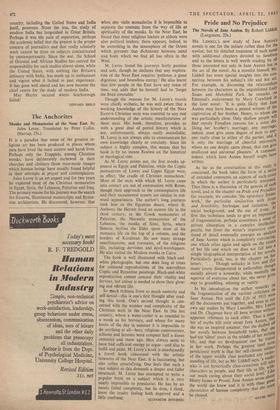Pride and No Prejudice
The Novels of Jane Austen. By Robert Liddell. (Longmans, 25s.)
MR. LIDDELL'S new study of Jane Austen's novels is one for the initiate rather than for the novice; but his detailed treatment of each novel with additional chapters devoted to Sanditon and to the letters is well worth reading by all those interested not only in Jane Austen but in the art of the novel. As a novelist himself Mr. Liddell has some special insights into the con- nection between his subject's life and her art- For example, in discussing the relationshiPs between the characters in the unpublished LadY Susan and Mansfield Park, he remarks on Edmund's enslavement by Mary Crawford in the later novel: 'It is quite likely that Jane Austen may have been a pained witness of the captivation of her brother, Henry, to whom she was particularly close. Only shallow people will find merely Freudian reasons for a sister dis- liking her brother's marriage; any marriage, indeed, must give some degree of pain to anY- one really close to either of the parties, and it is only the marriage of cheerful extroverts, whom no one deeply cares about, that can give unalloyed and universal pleasure.' A comment, indeed, which Jane Austen herself might have written.
As far as the construction of this study is concerned, the book takes the form of a series of extended comments on aspects of each novel in which the author is particularly interested. Thus there is a discussion of the genesis of each novel, and in the chapter on Pride and Prejudice, for example, we consider 'the epistolary fralne- work,' the particular similarities with Sensehe and Sensibility, burlesque and imitation, social background, and the use of ironY. first this technique tends to give an impression. of fragmentation, perhaps sometimes a sense or, private absorption in a complex intellectualm.; puzzle, but from the writer's impressive ca mand of detail eventually emerges an analri g,: of Jane Austen which is completely convincin one which relies again and again on the eve017 of her life and which yet does not fall jato.a simple biographical interpretation of her nove' ls,: Particularly good, too, is the chapter on he letters: `. . . Though unlucky in love and (for many years) disappointed in authorship, thouP socially almost a nonentity, while mentallY the. superior of everyone about her, she never p."' way to grumbling, whining or vanity. - •
In his introduction the author remarks
the fragmentation of the various critms °I.:I Jane Austen. Not until the Life of 1913 sveur all the documents put together, and even in nvis own age studies by Mary Lascelles, Mrs. Lea _t and Dr. Chapman have all been written apparent reference to each other. Thus a nu.tan_t ber of myths still exist about Jane Austen, M, she was an inspired amateur, that she dashed I` °he
her novels between household tasks, ti at.
had ten 'silent' years in the middle of her writnlei; life, and that no development can bed most in her work. Perhaps the greatest (and ,..nl.eet pernicious) myth is that her self-chosen suit.... un doe.r of the upper middle class precluded any standing of life, but as Mr. Liddell says, 'a re40 who is not hysterically class-conscious characters as people, and their life as life, iLike out much caring about their social level: bout Henry James or Proust, Jane Austen wrote a rot the world she knew and it is with these gost chroniclers of human complexity
that she
I
be classed.
DAVID grE5


































 Previous page
Previous page